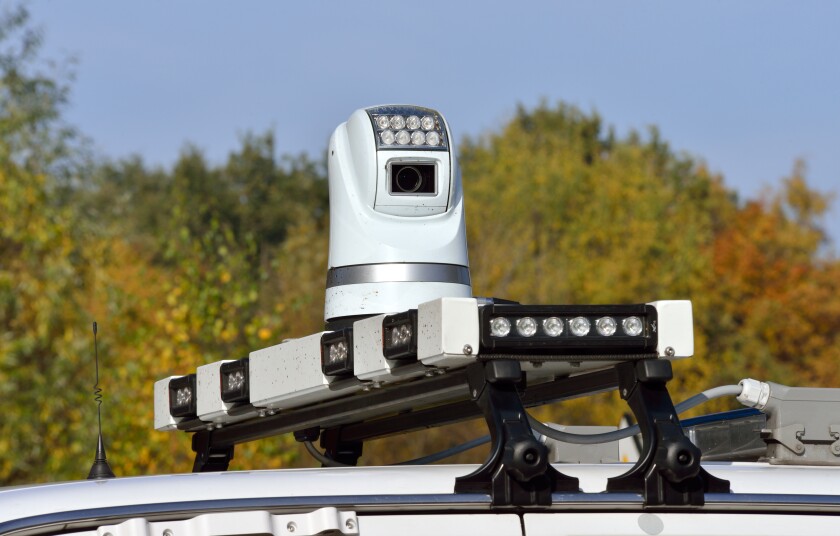The role of science in police work has long been established, but Yost’s analysts at the Ohio Bureau of Criminal Investigation (BCI) are gaining tools to examine guns and drug samples in a way few have ever seen.
Yost and lab specialists showed off the equipment last week, offering insight and explanations into analysts’ work. It puts what we have seen on television shows of crime-scene investigation, which often gloss over technical information and the work involved, into deeper context.
Specifically, the attorney general’s office is greatly expanding its ballistics testing, allowing more BCI offices to gain tools that connect the dots of crimes.
“What we know is guns are rarely used just once,” Yost said. “They’re used over and over again in violent crimes, and the people who use them tend to commit multiple crimes.”
Yost’s office, which oversees BCI, now has greater links to the National Integrated Ballistic Information Network. It is an imaging system that provides law enforcement the chance to compare fired casings from crime guns with casings seized from other places, a move that can link together other crimes. It is operated by the U.S. Bureau of Alcohol, Tobacco, Firearms and Explosives.
BCI’s laboratories in Bowling Green, London and Richfield have added new hardware that connects to the national network and allows the offices to accept crime guns and cartridge cases submitted by law enforcement agencies.
The state has five units that connect to the network. Previously, the BCI crime laboratory in Richfield was the only office that housed a unit, according to the attorney general’s office.
The network makes 3D scans of cartridge cases and compares them to the other images in the database. That allows the system to identify links to previously unconnected gun crimes statewide and across the country.
Cartridge cases and guns are collected from crime scenes after firearms have been fired, and they are later submitted to a BCI lab. Technicians enter the evidence into the ballistics network and then the images are examined by state agents or the ATF’s National Correlation and Training Center in Alabama. The items can be analyzed within hours, and results are shipped to local agencies quickly.
As more cartridge cases are entered in the network, law enforcement agencies can increase their chances of linking gun crimes and capturing criminals.
BCI is also using other key technologies in the fight against crime:
MX908 – New Drug Detection Equipment
Cuyahoga County and much of the state’s villages and cities continue to struggle with opioid overdoses. A vast majority of those deaths stem from fentanyl, which is much more powerful than heroin. In many cases, users had no idea that the drugs they bought contained the synthetic opioid.
In May, Yost’s office sent out an alert that BCI identified the first case of “rainbow fentanyl,” deadly colorful pills that resemble candy.
BCI Lab Supervisor Jessica Toms and BCI Special Agent Supervisor Scott Stranahan displayed the MX908 device, a portable instrument used to identify illegal drugs within minutes. The device was initially designed for weapons of mass destruction and detection in military applications.
As an example, Toms and Stranahan extracted a few grains of a substance and placed them on a strip. The strip was entered into the device. About a minute later, it concluded that the substance was methamphetamine.
The typical lab machine used to analyze drugs takes about an hour. The estimated cost of the new device is about $75,000.
The results from tests could be used for an assortment of court cases, from probable cause hearings to trials. Some jurisdictions may require results to come directly from a lab. The results must be re-analyzed if they are used in court proceedings.
“We do the traditional testing to prioritize the heavyweight cases,” Yost said. “Somebody who has kilos of fentanyl goes to the front of the line. We have relationships with additional labs we can bring in if we have too much work, because time is of the essence. We want to make sure that police can get these dealers off the streets and in the criminal justice system.”
The device is crucial to officer safety.
“We’ve had some incidents in which materials have been spread in patrol cars and jail settings, and this device can be used to test those things to make sure that those spaces are cleaned adequately before we put people back into those environments, and we ensure safety of our officers in handling those items,” Toms said.
Sixty counties in Ohio have access to use the device. More than 260 law enforcement officers are trained on how to properly use it. The device is still part of a pilot program.
A Firearms Laboratory
Inside of the laboratory in Richfield, Dylan Matt, a forensic analyst, fired two bullets into a water tank.
When bullets from crimes are sent to the lab, they sometimes contain marks and scratches because they strike items such as a wall or a car. One of the best ways to obtain bullets in pristine condition is to recover them in water.
Matt recovered the bullets from the water and evaluated them under his microscope in the lab. Reporters were able to observe a live image from the computer screen.
The generated test-fires and the evidence are placed side by side and then compared through a microscope. The live image allows Matt to look for individual characteristics that are unique to each firearm, he said.
The National Integrated Ballistic Information Network determines if a bullet or cartridge case was fired from a specific firearm that was previously used in a crime. Then, the firearms analysts must confirm the links.
The network could get investigative information to law enforcement agencies within hours or a short number of days. Without the technology, it could take months because of the large number of gun cases.
“Due to the nature of these cases, we have to document all of the evidence, compare it and then we have to have someone verify it,” Matt said. “So that whole process can take a little time. It all depends on the amount of evidence and the case. It’s hard to give it a set number of hours or days on a case at all.”
Investigations of Officer Shootings
In August 2022, Randy and Bradley Wilhelm were fatally shot by law enforcement officers after the brothers fired at deputies and state troopers during a nine-hour standoff. BCI seized more than 1,200 firearms and 140,000 rounds of ammunitions from the home located on Gilchrist Road in rural Knox County.
Mark Kollar is a BCI special agent supervisor and the author of “Best Practices for Investigating an Officer-Involved Incident.” Kollar shared evidence from the Knox County crime scene.
A BCI storage area contained sporting shotguns, high-caliber rifles and other materials collected as evidence in the shooting.
Any shooting involving an officer follows a systematic way of collecting facts and evidence. Additionally, BCI does not make the final determination of fault. It turns over its findings to county or state prosecutors to present to a grand jury.
The process played out in Akron in the shooting of Jayland Walker. A Summit County grand jury voted in April against charging eight officers who had fired 46 bullets into the Akron man.
“We just collect facts and turn them over to the county prosecutor with jurisdiction,” Kollar said. “And ultimately, it’s up to that prosecutor or a grand jury should they decide to give the ultimate decision as far as whether or not the use of force was a lawful circumstance.”
BCI also investigated the death of Arthur Keith, 19. He was shot by James Griffiths, a Cuyahoga Metropolitan Housing Authority officer, in November 2020. The officer was not charged.
Kollar said the special investigations unit of BCI writes and executes search warrants, interviews witnesses and collects video evidence.
In the case of the Wilhelm brothers, it took BCI nearly four days to clear the scene. The amount of time it takes agents to process a scene depends on complexity. Most scenes are completed within four to 24 hours.
When officers are involved in shootings, communities grow concerned about the decisions of grand juries. If BCI is called in, its goal is to have the investigation complete within 90 days.
BCI’s Crime Scene Unit Vehicle
The BCI truck contains hundreds of items that agents use to process a crime scene. The unit has a specific light to identify footwear impressions on floors and through dust, snow or salt.
It uses a black light to uncover biological fluids, such as semen and blood. The agents displayed evidence markers, as well as drones, that can be used to investigate a large area.
Dan Boerner, a BCI agent, said the agency’s trucks do more than carry equipment.
“That’s our mobile office,” Boerner said. “We rely on them to get us from point A to point B.”
©2023 Advance Local Media LLC. Distributed by Tribune Content Agency, LLC.











